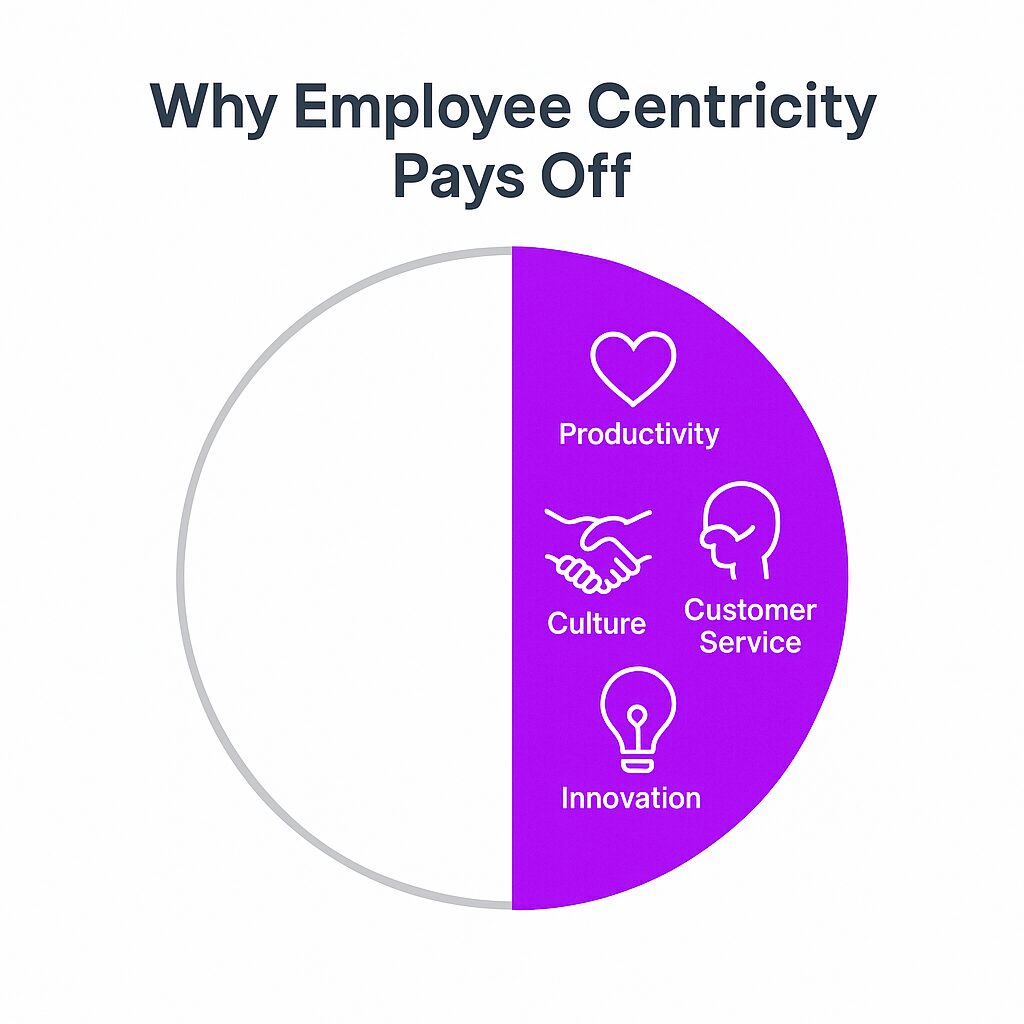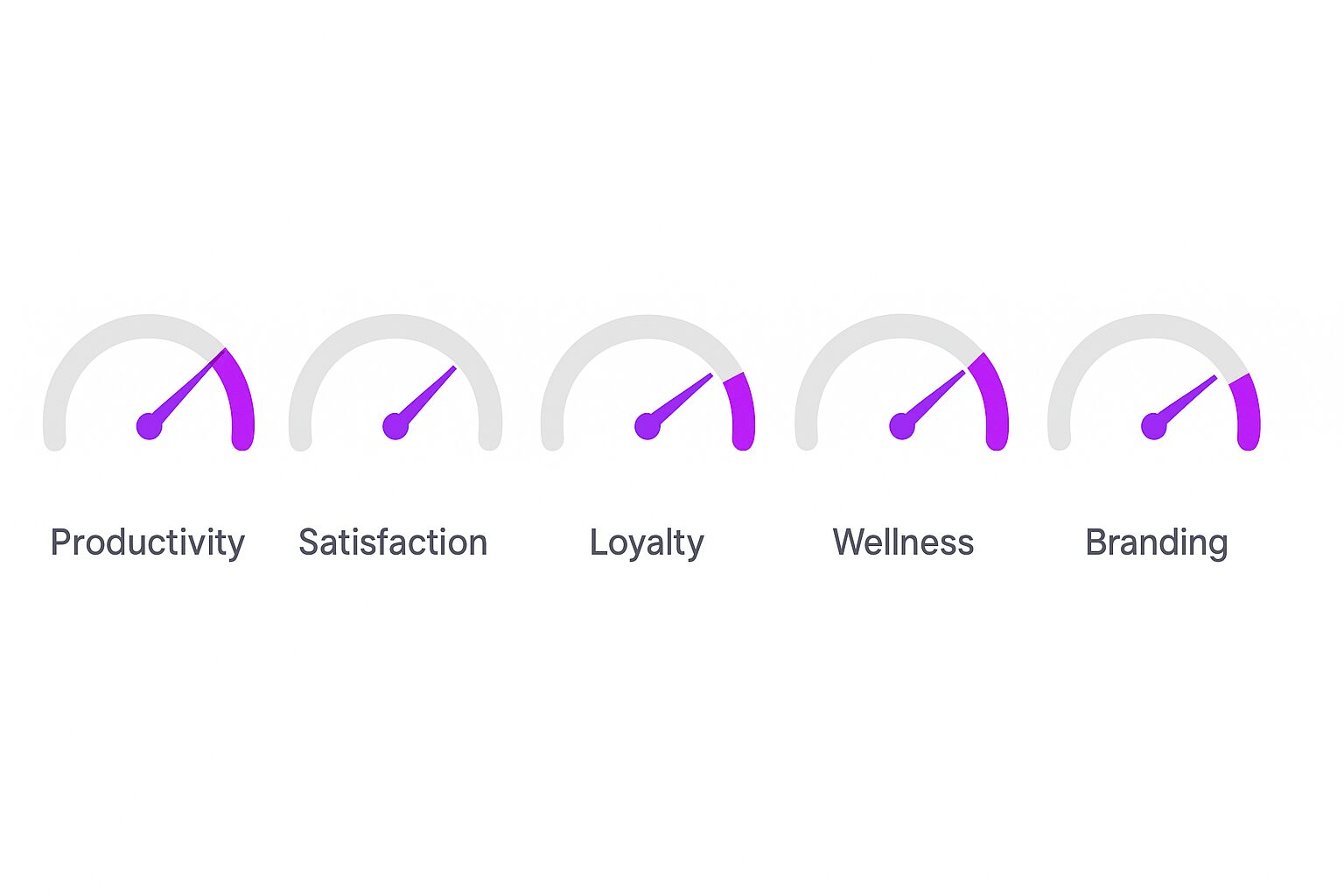What is Employee Centricity?
Employee centricity is the philosophy that places employees at the heart of business decisions, workplace culture, and organizational strategy. It means prioritizing employee well-being, professional growth, and engagement, recognizing that a satisfied workforce leads to higher productivity, better customer service, and stronger business results. Instead of viewing employees solely as resources, an employee-centric organization acknowledges them as the foundation of success by demonstrating employee centric leadership traits.
Understanding Employee-Centric Culture
An employee-centric culture is one where the company actively invests in the well-being and success of its workforce. Putting employees first is essential for establishing such a culture, as it demonstrates a commitment to their well-being and growth. It is built on trust, transparency, and respect. Organizations that embrace employee centricity provide meaningful work, career development opportunities, fair compensation, and a supportive environment. The goal is to create a workplace where employees feel valued, motivated, and connected to the company’s mission.
Unlike traditional business models that prioritize profits and customer satisfaction above all else, an employee-centric organization understands that engaged employees drive better customer experiences and long-term business success.
Why Employee Centricity Matters
Companies that prioritize employees reap multiple benefits, including enhanced employee productivity. When employees feel valued, they are more engaged, productive, and committed to their work. Satisfied employees contribute to enhanced staff retention and recruitment, serving as brand ambassadors and positively impacting the organization’s reputation, which in turn attracts top talent. Organizations that ignore employee needs face high turnover, low morale, and declining performance. Here’s why employee centricity is important:
-
Higher Productivity – Engaged employees put more effort into their work, leading to greater efficiency.
-
Lower Turnover Rates – Employees who feel valued are less likely to leave the organization.
-
Stronger Company Culture – A supportive workplace fosters collaboration, trust, and motivation.
-
Better Customer Service – Happy employees lead to satisfied customers.
-
Increased Innovation – Employees in a positive environment are more likely to contribute new ideas and solutions.
Benefits of an Employee-Centric Workplace
Increased Productivity
Employees who feel appreciated and supported tend to work harder. When employees are engaged, they bring more energy and focus to their roles, leading to improved performance and efficiency. Additionally, implementing employee rewards can further enhance productivity by fostering a supportive work environment.
Greater Job Satisfaction
A positive work environment leads to higher job satisfaction. Employees who enjoy their work and feel respected are more likely to stay committed to their organization.
Stronger Employee Loyalty
An employee-centric company fosters loyalty by demonstrating that it values its workforce. When employees feel respected and recognized, they are less likely to seek employment elsewhere.
Lower Stress and Burnout
Workplaces that prioritize employee well-being create a healthier balance between work and personal life. This reduces stress, burnout, and absenteeism, resulting in a more sustainable workforce.
Better Employer Branding
Companies known for prioritizing employees attract top talent. A strong reputation as an employee-centric organization makes recruitment easier and improves retention rates.
Enhanced Collaboration
A workplace built on trust and respect encourages teamwork. Digital tools play a crucial role in facilitating communication and collaboration among team members, especially in hybrid or remote work environments. Employees who feel heard and valued are more likely to share ideas, support colleagues, and contribute to a positive workplace culture.
Challenges of Implementing Employee Centricity
Resistance to Change
Some organizations struggle to shift from a traditional, profit-driven mindset to an employee-focused one. Leadership buy-in is essential for creating lasting cultural change.
Balancing Business Goals and Employee Needs
Finding the right balance between meeting business objectives and prioritizing employee well-being can be challenging. Companies must also foster a customer-centric culture, emphasizing the importance of balancing both employee and customer-centric approaches to build lasting relationships and achieve higher profitability. Companies must ensure that policies are both employee-friendly and aligned with strategic goals.
Measuring Impact
It can be difficult to quantify the success of employee-centric initiatives. Organizations need to establish clear metrics to track employee satisfaction, engagement, and performance improvements.
Ensuring Fairness and Consistency
Employee-centric policies must be applied consistently across the organization. Favoritism or uneven implementation can undermine trust and morale.
How to Build an Employee-Centric Organization
Transparent Communication
Open and honest communication is a cornerstone of an employee-centric culture. Active listening is a crucial skill for fostering a psychologically safe work environment. Employees should feel informed about company goals, changes, and expectations. Leadership should encourage feedback and actively listen to employee concerns.
Employee Empowerment
Giving employees the autonomy to make decisions and contribute to company initiatives fosters a sense of ownership and responsibility. When employees have a voice in the workplace, they feel more engaged and invested in their work.
Flexible Work Policies
Flexible work arrangements, such as remote work options, hybrid schedules, and flexible hours, support work-life balance and employee well-being.
Professional Growth and Development
Investing in employee development shows a commitment to long-term success. Training programs, mentorship opportunities, and career advancement paths help employees grow within the organization.
Recognition and Appreciation
Employees who feel recognized are more motivated. A culture of appreciation can include formal recognition programs, peer-to-peer recognition, and simple gestures like thank-you notes or team shoutouts.
Health and Well-being Initiatives
Employee wellness programs that include mental health support, wellness incentives, and resources for managing stress contribute to a healthier, happier workforce.
Inclusive and Diverse Workplace
A truly employee-centric company values diversity and inclusion. Human resources play a crucial role in evolving traditional practices to cultivate an inclusive and employee-centric work environment. Creating an equitable workplace where everyone feels respected and valued strengthens company culture and engagement.
Related Concepts
Employee Engagement
Engaged employees feel connected to their work and the company’s mission. Employee centricity plays a key role in fostering engagement.
Employee Experience
Employee experience encompasses everything from onboarding to daily work interactions. A positive experience leads to higher satisfaction and productivity.
Workplace Culture
Culture defines how employees interact and collaborate. An employee-centric culture is built on trust, respect, and shared values.
Leadership Development
Strong leadership is essential for building an employee-centric workplace. Training managers to support and empower their teams enhances engagement and morale.
Real-World Examples of Employee Centricity
Tech Industry
Many leading tech companies prioritize employee experience through flexible work policies, wellness programs, and strong company cultures. For example, Google provides employees with career development opportunities, wellness benefits, and an inclusive workplace culture.
Retail and Hospitality
Companies like Starbucks and Zappos have built employee-centric cultures that prioritize customer service by ensuring employees feel valued and engaged.
Remote Work Success Stories
Organizations that have embraced employee-centric remote work policies have seen increased productivity and satisfaction. Employee-centric organizations understand the importance of adapting processes and tools to prioritize employee needs in remote and hybrid work models. Companies that trust employees to manage their schedules often report higher engagement and lower turnover.
Final Thoughts
Employee centricity is not just an HR initiative—it’s a business strategy. Organizations that prioritize employees create workplaces where people feel valued, respected, and motivated. When employees thrive, businesses grow. Companies that invest in their workforce see higher productivity, stronger loyalty, and a more positive company culture.
The key to long-term success lies in building a workplace that puts employees first. A truly employee-centric organization understands that a motivated and engaged workforce is the foundation of sustainable growth and innovation.







